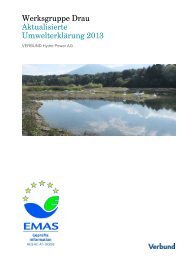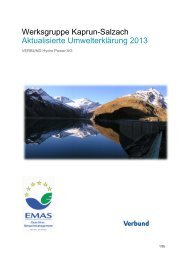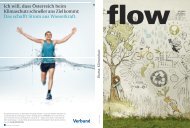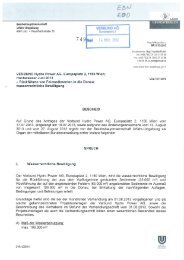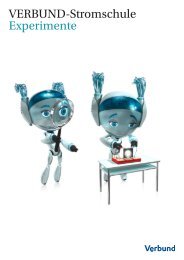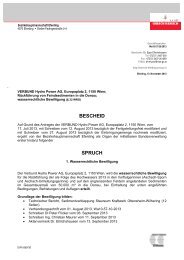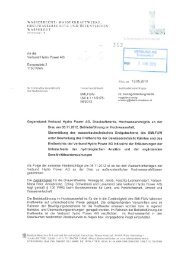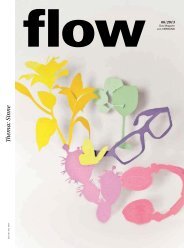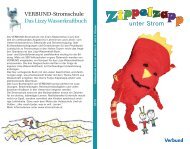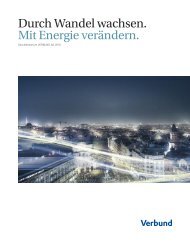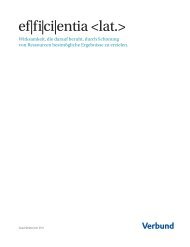Download PDF - Verbund
Download PDF - Verbund
Download PDF - Verbund
You also want an ePaper? Increase the reach of your titles
YUMPU automatically turns print PDFs into web optimized ePapers that Google loves.
The next generation<br />
of trees grows beneath<br />
the masts.<br />
VERBUND: THE TIE THAT BINDS<br />
It’s the kind of day you’d like to stay indoors – cold,<br />
wet and windy. We haven’t had an October like<br />
this in a long time. We arrive at the reforestation<br />
area in Oberwart, Burgenland – and off we go. Left<br />
and right we see a thick forest, separated by an<br />
approximately 60 metre wide path in the middle.<br />
Electrical masts tower over a light fog. “We have<br />
three different research areas here; the first is fenced<br />
in, the second has individual tree protection and<br />
the third uses a spray to protect from wild animals”,<br />
says Herbert Forstner, project manager for forestry<br />
matters. But the fenced-in area he shows us has<br />
no trees – just tall grass. It looks like only weeds<br />
are growing here. We enter the first research area,<br />
and now we know why there are no tall trees:<br />
the seedlings are still very young. Upon closer<br />
examination, we see small hornbeams, alders<br />
and oaks.<br />
GONE WILD<br />
Attempts are being made here to determine the<br />
best type of wildlife protection: the first with<br />
fencing, the second with individual tree protection<br />
via plastic covers and the third with painting or<br />
spraying trees with special substances that keep<br />
wildlife away but are not harmful to plants. This<br />
is necessary for the reforestation research areas.<br />
“Wildlife likes young trees – they are apparently<br />
delicious”, says Reinhard Barbl, head of forest<br />
ecology construction supervision for the Styria<br />
line. This is why the first area is fenced in. It takes<br />
two people to get the big gate open. Bright dots<br />
appear in the second research area. No, it’s not<br />
autumn leaves, it's the substances sprayed on the<br />
plants to keep wild animals away. The trees in the<br />
third research area look like they’re encased in a<br />
grid. These are starch-based plastic covers that<br />
protect against wild animals and biodegrade in<br />
ten years.<br />
Apart from large wild animals, the young trees<br />
are threatened by rodents like mice and rabbits.<br />
This gives rise to another problem: foxes or other<br />
natural enemies of the small rodents can’t enter the<br />
fenced area. An innovative solution was developed<br />
to prevent overpopulation. Three metre stilts have<br />
been placed around the grounds. They seem to say<br />
STUDENTS REPORT: ECOLOGICAL SUPPORT FOR THE STYRIA LINE | SUSTAINABILITY REPORT 2009 | 37<br />
“room for rent, all you can eat” – a type of neon<br />
sign for buzzards and falcons.<br />
ONE TO ONE<br />
Replacement planting is a simple idea. For every<br />
space cleared, we have to offer nature an acceptable<br />
substitute. Forestry law demands it. During the<br />
construction of the Styria line, every hectare of<br />
forest cleared had to be balanced out with the same<br />
size space, planted with a minimum of 2,500 trees.<br />
It’s a one-to-one ratio, though it depends on the<br />
state's percentage of the forest. This ensures that<br />
in Austria, forests – as a habitat and a commercial<br />
resource – will not decrease.<br />
ALL PLANTS ARE NOT CREATED EQUAL<br />
“Common spruce trees grow like crazy because of<br />
dissemination – we haven’t planted a single one!”<br />
says Mr. Barbl. “They weren’t originally here – this<br />
is not their original habitat”, he adds. They also<br />
bring pests like bark beetles. But they’ll be left in<br />
peace, because “Everything that comes from nature<br />
is good”. This area won’t be recognisable in 50 years.<br />
When the forest gets free space and light, it will<br />
grow all on its own – “natural rejuvenation”, our<br />
expert tells us.<br />
It’s useful and intentional, but in the case of the<br />
spruces, it's not so desirable. “They’re not really suited<br />
for this regional climate. We’ll see that in 25 years<br />
when they begin to rot”, the forestry expert says. Now,<br />
time itself will have to re-create an intact ecosystem.<br />
BACK TO THE FUTURE<br />
The educational trail at the forest in Unterwart is<br />
like a time warp. Here we see all the young plants<br />
from the planting areas in an advanced stage of<br />
development. The educational trail is part of a<br />
reforestation project implemented with multiple<br />
partners. Each tree has a sign that explains exactly<br />
what type it is. There is plenty of reading to do on<br />
the 48 different plants. Birch, sweet chestnut, Scots<br />
pine, Norway maple, hazelnut, blackthorn bushes ...<br />
the array of species seems infinite. Corn rustles in<br />
the adjacent field. Nature can be so beautiful, but we<br />
humans aren’t always the best custodians.



